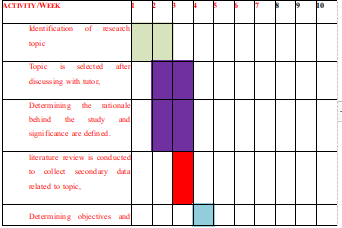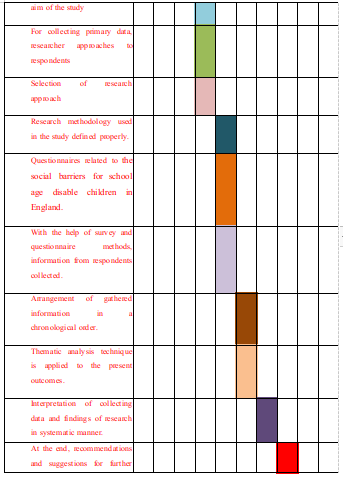Title:
What are the social barriers for school age disable children in England?
Introduction
In our day to day lives, we all come across obstacles that interfere with our day to day activities. However, the people living with disability are even faced with more challenges because of their condition. According to world health organization (WHO), these barriers are factors in a person's environment that limit the way they function and create disability (CDC, 2016). Some of these environmental factors that affect disabled people may include un-accessible physical environment, lack of relevant technology, negative attitudes from people just to mention a few.
Background
According to Thomas Coram Research Unit (TCRU), the number of children with disabilities in England is between 288000 and 513000 (Haringey council services, 2016). However, these children require some special needs and sometimes the needs are complex and change with time. Many people have done a lot of research and studies with the goal of understanding the needs and developing a system that will suit and ease the challenges faced by the disabled people and their families. However, with the increasing number of children with disabilities, the society is not yet able to solve the challenges and barriers to a considerably good level (Peacock, 2016).It is thus important to continue doing research so as to reduce as much as possible the challenges facing disabled people and in particular children with disabilities.
There are certain issues and gaps facing the disabled children and something need to be done to reduce the issues and bring the difference to the minimum possible. Some of these issues and gaps include: twenty-nine percent of disabled children in England live in poverty. Percentage of disabled children who attain the education is way too low then the percentage of children without disabilities achieving the education. The percentage of schools with accessibility plans for disabled children is also a problem because it is less than 50%. There is a high level of unmet needs, isolation and stress as reported by the families of children with disabilities. DfE also reports that only four percent of the disabled children get support from social services, and also the children with severe disability are being prioritized compared to those with acute disability (Haringey Council Services, 2016).
This statement from the DfE is critical regarding this project because it gives us a clear understanding of the issue at hand. If a certain problem is to be solved, one of the best approaches is to know the cause of the problem. For this reason, many people have conducted research to know the cause of disability in children and they have all come up with their findings and conclusions. One of these studies knows the root causes of disabilities be it a developmental or acquired disability (Bedell and et.al., 2013). One of the ways of reducing the social barriers affecting school age children is reducing the number of disabled children (Anaby, and et.al.,2014). This can only be achieved if we reduce the risk factors causing disability. Such studies are therefore of much relevance in this project because the findings will help us during our research.
People have also done studies with a goal of knowing some root causes of social barriers. These studies are also of much importance to this project because it allows us to know some problems that have been addressed and if the measures taken are effective or not. The studies also help the researcher to innovate new ideas that will reduce the social barriers. Statistical data provided by units like TCRU is also important because it will help us know the approximate percentages of disabled children, receiving some social services. We will also be able to approximate the percentage of disabled children facing social barriers in the society. These are just some examples of studies and researches conducted by people, and they are of importance in this project. In the project report, these and other studies will be discussed in detail with a goal of helping us come up with solutions that will deal with the social barriers affecting the quality of life for disabled children. This secondary research is important because it will also help me have a good understanding of what other people have done, and this way I will not have to repeat what they have done, in case I intend to do primary research in future.
Rationale of the project
The main aim behind carrying out the project is to identify the key social barriers for school age disable children in England. There are many barriers that disabled people come across. Examples include; attitudinal barriers, communication barriers, physical barriers, policy, programmatic, social and transportation just to mention the most common ones (Bradshaw and Hall, 2013). However, in this project proposal, we will focus on social barriers. Talking of social barriers, these are conditions in which disabled people are born, grow, live, learn, work and age that decreases their functioning (CDC, 2016). An example of a social barrier is that children with disability are to experience violence than children without disabilities (WHO, 2012). This proposal will address this issue of social barriers affecting school-aged children, and what can be done to reduce these barriers.
Projects aim
The main aim behind carrying out this research project is to analyze the social barriers for school age disable children in England.
Objectives
- To understand the social barriers facing the disabled school-aged children
- To identify the potential impact of social barriers on the life of disabled children
- To recommended key strategies which can be adopted by students and their families to deal with key social barriers and overcome the same.
Literature search strategy
In the current day world, one of the most important assets in any research is the internet. The internet has a wide range of academic resources from books, journals to articles and they will all be used while conducting the research. These resources will be accessed through search engines such as Google and Yahoo. Several other important websites such as World Health Organization (WHO), UNICEF, CDC, DfE, Disability Rights UK, disability matters among others. However, the keywords that will lead to all these websites are the social factors affecting the disabled youth negatively. Apart from this, the work of other authors and scholars will be also taken into consideration for carrying out potential search for this project. Studies on social barriers, students of UK etc. will be taken into consideration.
Ethics and anti-oppressive practice considerations
Many professional areas are governed by a code of ethics, and social work is not an exception. Code of ethics in social work is the rules that govern/guides social workers on how to handle responsibly their clients, colleagues, employers, and how they carry out their profession in general (Ingrao, 2015). When people use power to dis-empower or marginalize a social group, then it is called oppression. Anti-oppression practice is thus recognizing the oppressions that exist in social work and attempts to reduce its effects. Social work's main aim is to promote social inclusion. Anti-oppressive practice is one of the practices that help achieve this aim. Oppression towards the disadvantaged people comes as a result of either the way processes operate or may result from an individual's preconception. Children with disabilities are one of the groups of socially disadvantaged people and the people providing social care or interacting with them should possess anti-oppression tactics so as to promote social inclusion. A social worker who practices good code of conduct and anti-oppression tactic will reduce the extent to which the disadvantaged people are socially excluded.
In this project, the causes of social barriers amongst children will be investigated keenly, to determine those that may have been caused by a poor code of conduct by the social workers and oppression behavior. Upon realizing any misconduct or oppressive behavior, I will come up with recommendations that if implemented, they may reduce the oppression and enhance the services offered to the disadvantaged children.
Project outline
Chapter 1:
Introduction
In this section of the main project, a brief introduction of the research question will be discussed to help understand the issue at hand. This is a paramount section of the project because it gives the reader a clear view of what he/she will come across in the project report.
Background and the logic of the research
The background is where the researcher explains the problems he/she has observed. For instance, this part will address the issue of social barriers that are facing school-aged children with disabilities. The section will look at the root causes of these barriers and how they have impacted the life of children with disabilities. Other people's studies and research regarding this issue of social barriers will also be discussed here. Their findings will be compared and used later for conclusions and recommendations. The purpose of this project will also be explained here in detail with the aim of helping the reader understand the problem properly and see its impacts to the said disadvantaged group. Still, under this title, the relevance of secondary research will be addressed in detail. The projects aim and objectives can also fall under this part of the project. Statistical data will also be presented in this part of the project. A person reading this section will have a good understanding of the problem by the end of this subtopic. Ethics and anti-oppressive practice will also be discussed in this section.
Chapter 2
Literature review
All the relevant literature supporting this project and that has not been discussed in the background section will be discussed here. The objectives will also be broken down into subheadings and then discussed in detail, to explain how specific objectives will be achieved. This chapter helps the reader to understand any issue that may be unclear from the previous chapter.
Chapter 3
Analysis
It is on this topic that we will touch on different theoretical models and case studies which may be of help in solving the social barriers affecting the disadvantaged. Coming up with models and strategies that could solve or reduce the problem of social barriers will also be done in this chapter. A program or strategy in practice aimed at tackling the issue can also be assessed here and its strengths and weaknesses identified
Chapter 4
Conclusion and recommendations
This is the termination of the project, and thus any studies and research did in the project secondary research will be summarized here. This section will also touch on what have been achieved in the course of the project and what may be done differently, in case such a project was done again. Recommendations of what the writer thinks could be done to solve the problem will also appear in this section.
Project time frame
Having concluded the project proposal in this semester, the secondary research will begin immediately after the Christmas vacation is over. I.e., from 6th January 2017 to 31st March. This means I will be left with one and a half month to compile and write a comprehensive project report. By April 1st, it's my hope that I will be through, waiting for the submission date.



References
- Bradshaw, P. and Hall, J. (2013) Health and community care the impact of disability on the lives of young children: Analysis of data from the growing up in Scotland study. Available at: http://www.gov.scot/Resource/0043/00434087.pdf (Accessed: 29 November 2016).
- CDC (2016) Common barriers to participation experienced by people with disabilities. Available at: http://www.cdc.gov/ncbddd/disabilityandhealth/disability-barriers.html (Accessed: 29 November 2016).
- Haringey Council Services (2016) Disabled Children and Young People. Available at: http://www.haringey.gov.uk/social-care-and-health/health/joint-strategic-needs-assessment/health-mothers-children-and-young-people/disabled-children-and-young-people (Accessed: 29 November 2016).
- Ingrao, C. (2015) What Is the Social Work Code of Ethics? Available at: https://socialwork.simmons.edu/social-work-code-of-ethics/ (Accessed: 29 November 2016).
- Peacock, J. (2016) Disability in the United Kingdom. Available at: http://www.papworthtrust.org.uk/sites/default/files/Disability%20Facts%20and%20Figures%202016.pdf (Accessed: 29 November 2016).
ct pro



 Company
Company

















